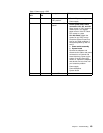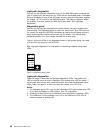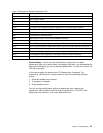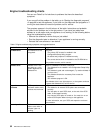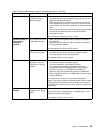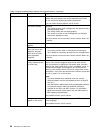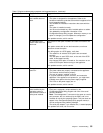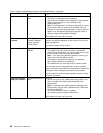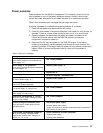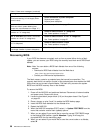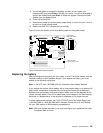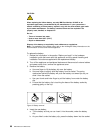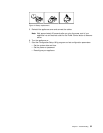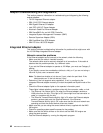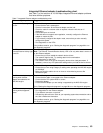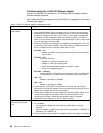
Power problems
Power problems can be difficult to troubleshoot. For example, a short circuit can
exist anywhere on any of the power distribution busses. Usually a short circuit
causes the power subsystem to shut down because of an overcurrent condition.
Table 6 lists the power error messages that you might encounter.
A general procedure for troubleshooting power problems is as follows:
1. Power off the system and disconnect the AC cord(s).
2. Check for loose cables in the power subsystem. Also check for short circuits, for
example, if there is a loose screw causing a short circuit on a circuit board.
3. Remove adapters and disconnect the cables and power connectors to all
internal and external devices until the NAS 200 engine is at minimum
configuration required for power on.
4. Reconnect the AC cord and power on the NAS 200 engine. If the engine
powers up successfully, replace adapters and devices one at a time until the
problem is isolated. If the engine does not power up from minimal configuration,
replace FRUs of minimal configuration one at a time until the problem is
isolated.
Table 6. Power error messages
Message Action
Power supply ″X″ current share fault
(level-critical; excessive current demand on
power supply ″X″)
1. See “Power problems”
Power supply ″X″ DC good fault
(level-critical; power good signal not detected
for power supply ″X″)
1. Replace power supply ″X″
Power supply ″X″ temperature fault
1. Replace fan ″X″
Power supply ″X″ removed
1. No action required - information only
Power supply ″X″ fan fault (level-critical;
fan fault in power supply ″X″)
1. Replace power supply ″X″
Power supply ″X″ 12V fault (level-critical;
overcurrent condition detected)
1. See “Power problems”
Power supply ″X″ 3.3V fault (level-critical;
3.3V power supply ″X″ had an error)
1. See “Power problems”
Power supply ″X″ 5V fault (level-critical; 5V
power supply ″X″ had an error)
1. See “Power problems”
System over recommended ″X″ current
(level-non-critical; system running too much
current on that voltage)
1. See “Power problems”
System running non-redundant power
(level-non-critical; system does not have
redundant power)
1. Add another power supply
2. Remove options from system
3. System can continue to operate without redundancy protection if 1
and 2 above are not followed.
System under recommended voltage for
″X″ v (level-warning; indicated voltage
supply under nominal value; value for ″X″
can be +12, -12, or +5)
1. Check connections to power subsystem
2. Replace power supply
3. Replace power backplane
Chapter 7. Troubleshooting 57



